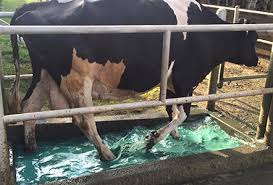
Hooves of animals should regularly be attended to, like lameness, due to hoof abnormalities, which may be detrimental to the grazing ability of the animal. The condition of the animal deteriorates and secondary infections such as foot rot may result.
Preventive Treatment
Footbath containing 2 – 4% formalin or 10% copper sulphate should be a regular practice, especially where crowding of animals takes place under moist conditions.
Abnormal Growth
The hooves should regularly be inspected for any abnormal growth, which may result in hoof-cracking or other bone abnormalities. This can be rectified by cutting it with bone cutters or knives and painting it with
Inflammation with Infection
Footrot may occur in cattle and sheep under moist conditions. An organism (Bacteroides nodosus) penetrates and causes inflammation to the structures of the hoof, resulting in infection of the ligaments and bones of the foot. If diagnosed early, the animal can be treated with local and systemic antibiotics.
If complications such as suppuration and abscess-formation set in, the animal must be cast for treatment. All necrotic tissue should be cut away from the hoof. Do not be alarmed if there is bleeding. Thereafter, treat with local as well as systemic antibiotics. If the joints are also affected, hot fomentations should be applied.
Treatment requires time and effort and should be tackled locally as well as systemically. Veterinary assistance and advice are therefore essential.
Hardening of Hooves
By means of the regular local application of methylated spirits, the hooves (of pigs) may be hardened.
A person familiar with the procedures must first demonstrate all these procedures before you attempt it under supervision.
Click here to view a video that explains the treatment of hooves.